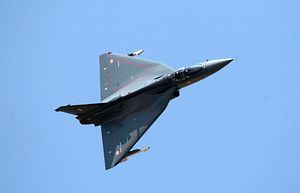This week, the Indian Air Force (IAF) is holding one of its largest live fire exercises. The drill, codenamed Iron Fist, is taking place in the Thar Desert in Pokhran, Rajasthan in northwestern India, according to a press release. The combat drill will involve 181 IAF aircraft and will be witnessed by Indian President Pranab Mukherjee and Prime Minister Narendra Modi.
The Iron Fist exercise was first held in 2013 to practice and showcase the IAF’s tactical skills in aerial combat and close-air support operations. The day-and-night drill will be divided up into six segments: the flypast, offensive capabilities, defensive capabilities, network-centric drills, ground support, and night operations. The drill will involve the Garud Commando Force, the IAF’s Special Forces unit, as well as two IAF aerobatic squadrons.
According to IAF Air Marshal BS Dhanoa, vice chief of the Air Staff, the aim of the exercise is to demonstrate a well-coordinated “aerial ballet” showcasing the IAF’s “capability to punish” over the entire spectrum of aerial operations. Among other things, this year’s IAF drill will focus on “all weather, network-centric operations, precision weapon delivery and ability to deliver lethal firepower.” Referring to the IAF night operations during Iron Fist, Dhanoa explained: “This will be a display of the day-and-night capabilities of the Indian Air Force. We did not have this in the last decade. During the Kargil war, we did not have it.”
Dhanoa also pointed out that the military attaches of China and Pakistan have not been invited to witness the combat demonstrations of the IAF.
Some of the aircraft that will participate include the Sukhoi Su-30, Mirage 2000, Jaguar, and MIG-21 fighter jets, attack helicopters (including the Light Combat Helicopter), drones, and Airborne Warning And Control Systems (AWACS) planes. The Tejas Light Combat Aircraft (LCA) will also make an appearance during the exercise.
The LCA, developed by the Aeronautical Development Agency in cooperation with Hindustan Aeronautics Limited (HAL), is a supersonic, single-seat, single-engine multirole light fighter aircraft and has been under development for the past three decades.
I explained back in January:
The Indian Air Force (…) abandoned plans to develop an upgraded Mark-II Tejas LCA and instead will field an improved Mark-I Tejas LCA — dubbed Tejas Mark-IA (…) The first 20 Tejas LCA are slated for induction in 2017 or early 2018.
The IAF intends to procure a total of 105 LCA and has already ordered the first batch of 40 aircraft (20 under initial operational clearance standards and 20 as per final operational clearance standards). Some reports indicate that the IAF might order additional LCA beyond the 105 aircraft cited above.
During Iron Fist, the LCA is slated to fire the U.S.-made Griffin beyond-visual-range air-to-air missile, as well as the Russian-made R-73 short-range air-to-air missile. The LCA is expected to achieve final operational clearance at the end of the month, although a delay seems likely.
The Iron Fist exercise will also see the test-firing of the indigenously-developed Astra beyond-visual range air-to-air missile. The missile will be tested from a Sukhoi Su-30 fighter jet.
The IAF is currently suffering from a number of deficiencies, including low operational availability (on average at 60 percent) and a complicated and poorly managed procurement process. With older planes like the MIG-21 and MIG-27 slowly being phased out, the IAF will at least need 400 new combat aircraft over the next ten years to keep up current combat strength. At the moment, the IAF is also facing a critical shortage of fighter pilots.
As I reported previously:
The Indian Air Force currently operates 32 (some sources say 35) combat squadrons. However, the Indian government’s 35-member Standing Committee on Defense said in a report this April that the number of squadrons could drop as low as 25 (See: “The Indian Air Force’s Big Problem: Not Enough Pilots”).

































